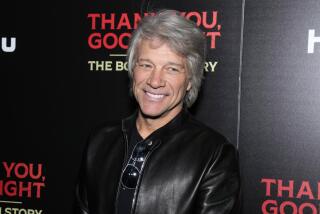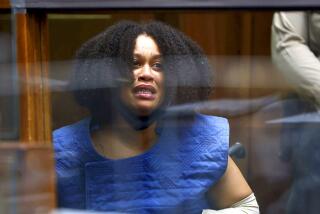After the Leap, Soul-Searching in Seattle
SEATTLE — As morning commutes go, this one was a doozy. First they shut down Interstate 5 for four hours because a woman was straddling a bridge over the Washington Ship Canal, threatening to jump. Horns honked, windows got cranked down in irritation. Eventually, people started yelling at the small, scared figure up on the railing. “Jump, bitch, jump!” someone shouted. “Get it over with!” yelled another. A few people down below tried to figure out how they could make a quick banner that would say, “JUMP.” Didn’t have any paper long enough. Went back to their cars.
By this time, it had become more than a matter of life and death. It was a morning commute that had failed in a big, big way, and when the young woman finally cannonballed down into the water--from which she was quickly plucked, flailing and injured, but alive--so many other things had gone wrong: meetings missed, children late for camp, planes and ferries departed.
In the ensuing debate since Tuesday’s near-tragedy, there has been an outpouring of cards, flowers, Beanie Babies and balloons from well-wishers to the woman at Harborview Medical Center and more than a little grieving for a city that had once seen itself as a beacon of civilized society--a city that woke up that morning on I-5 with a hangover and a bunch of bad companions it claimed not to recognize.
Forget Los Angeles, the city that Seattle always agonizes it’s about to turn into; the awful words “New Jersey” have started coming up.
“The woman picked a lousy time to wrestle with her demons,” the Seattle Times said in an editorial. “But despair doesn’t wear a watch
The 26-year-old woman, said to be a state legislative analyst, was upgraded from critical to serious condition, and it was thought she would survive. Seattle, that’s another matter--at least the Seattle everybody thought they were moving to when they sold their homes in L.A. and San Francisco and New Jersey and moved here.
That Seattle was the place consistently rated among the nation’s most livable cities through the early 1990s, the city that scored highest on the politeness index when wallets were dropped all over America and the number returned was tallied. It was the city that Boeing claimed as its corporate flagship, where Mt. Rainier’s glacial ice gleamed orange over the summer dusk.
Consider what has happened in the last few years, and it is perhaps easier to understand why one woman’s despair and the response it elicited have launched an intense new round of civic soul-searching.
Start with the dot-com meltdown, which has thrown 11,300 high-tech workers into the streets since January and cost Microsoft employees alone at least $2.6 billion in unexercised stock options. Then Boeing’s headquarters abandoned the city, declaring Chicago--say what?-- a more desirable corporate locale.
Mt. Rainier National Park now has the worst smog in a region that is growing hazier every summer. Forget the World Trade Organization riots and the Mardi Gras fracas that turned into a virtual race riot (in a city that saw itself as an example of racial tolerance)--what about the traffic?
Each workday, Seattle swells from a population of about 600,000 to more than 1 million, nearly all swooping in by car. The city this year earned the distinction of having the nation’s second-worst traffic congestion, behind L.A., and you can imagine the response to rubbing shoulders with that particular metropolis.
Worse, there is absolutely no end in sight. A light-rail system that has been years in the planning has oozed into a quagmire of budget overruns that now approach $1 billion. And in late July, the state Legislature adjourned its fourth special session of the year--a session convened to pass a $17-billion traffic relief overhaul--without doing anything at all.
Analysts blamed it on political paralysis, with a House split between 49 Democrats and 49 Republicans. And a lot of people in Seattle started wondering exactly who they were supposed to be patient with, and for how much longer. That’s the big picture. The other picture is where people’s lives flow across the wide civic landscape, where one woman clutches the railing of a bridge, and a man below has his kids in the back of the car on his way to work because his nanny didn’t show up.
“This is sad evidence that we are moving from a culture of care to a culture of commerce, where obligations are so pressing on families, and time is so short that it’s almost like the well of civility is beginning to run dry,” said John Kydd, a Seattle lawyer. “We can only ask so much of overcommitted parents and others before they lose their reserve.”
“We see it every day,” said Jill Larson, an executive assistant at a financial firm. “I passed a homeless woman just now on my way down the hill; she was barefoot, weaving around the sidewalk and singing, and I didn’t do anything. Just avoided her. I’m just as much part of the problem as the people on the freeway.”
Police said the taunts began almost immediately after the first southbound lanes of the freeway atop the 160-foot bridge were closed off shortly before 6:20 a.m. Motorists crawled by, and a few shouted out their windows, said Seattle police spokesman Duane Fish. “Apparently, when people would yell for her to jump, she would look up and take her gaze off from down below. So it was our negotiator’s interpretation that, yes, in fact she had heard some of the stuff,” Fish said. “Basically, people were yelling at her to get it over with .... There was some profanity used.”
It wasn’t until more than 31/2 hours later, at 10 a.m., that the final report came over the police dispatch line. “She’s in the water.”
“She just kind of cannonballed,” Holly Viola, who was caught in the traffic jam, told the Seattle Post-Intelligencer. Then came the part that turned the story around. The part where the woman who had been urged to die came up flailing instead. Not dying. With a broken spine and severe chest and abdominal injuries, trying to live. “She came up and she was swinging her arms,” Viola said. “Trying to swim.”
That’s when people like Debbie Guerrero showed up at the hospital with a letter the following day, saying she hadn’t been able to sleep the night before. When e-mails and phone calls flooded local newspapers and talk radio stations. “I was hoping to send a letter to her, just to let her know that normal, decent people can empathize with her, and not everyone in Seattle thinks that getting to Microsoft is the end-all and be-all,” Emily Rosenberg wrote.
“I can tell you, the true Seattle is the hundreds of flowers and letters that went out to the lady who jumped. I even sent one. I think we’re a caring city,” said Mayor Paul Schell.
At one of the city’s famous coffee shops last week, Jena Peterson stood in line. “I don’t know if Seattle is changing, or if we are just being forced to realize that we are just like everybody else,” she said. “No more of this thinking of ourselves as ‘nice,’ no more pretending we don’t jaywalk. I want to bring my daughter up in a compassionate place, not in isolation, and I don’t know where that would be.
“I guess I am just disappointed.”
*
Times researcher Lynn Marshall contributed to this story.
More to Read
Sign up for Essential California
The most important California stories and recommendations in your inbox every morning.
You may occasionally receive promotional content from the Los Angeles Times.










